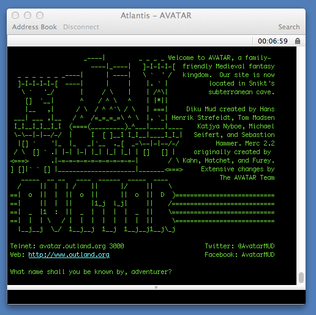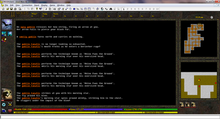A multi-user dungeon, also known as a multi-user dimension or multi-user domain, is a multiplayer real-time virtual world, usually text-based or storyboarded. MUDs combine elements of role-playing games, hack and slash, player versus player, interactive fiction, and online chat. Players can read or view descriptions of rooms, objects, other players, and non-player characters, and perform actions in the virtual world that are typically also described. Players typically interact with each other and the world by typing commands that resemble a natural language, as well as using a character typically called an avatar.
In multiplayer online games, a MUSH is a text-based online social medium to which multiple users are connected at the same time. MUSHes are often used for online social intercourse and role-playing games, although the first forms of MUSH do not appear to be coded specifically to implement gaming activity. MUSH software was originally derived from MUDs; today's two major MUSH variants are descended from TinyMUD, which was fundamentally a social game. MUSH has forked over the years and there are now different varieties with different features, although most have strong similarities and one who is fluent in coding one variety can switch to coding for the other with only a little effort. The source code for most widely used MUSH servers is open source and available from its current maintainers.

Star Wars Jedi Knight II: Jedi Outcast is a 2002 first- and third-person shooter video game. The Microsoft Windows was developed by Raven Software, the Mac OS X version by Westlake Interactive, and the Xbox and GameCube versions by Vicarious Visions; most versions were published by LucasArts, with only the Mac version published by Aspyr. The game is a sequel to 1997's Star Wars Jedi Knight: Dark Forces II, and the third main installment in the Star Wars: Jedi Knight series. The single-player campaign, set in the fictional Star Wars expanded universe two years after the Mysteries of the Sith expansion for Dark Forces II, follows returning protagonist Kyle Katarn, a mercenary working for the New Republic and former Jedi who cut his connection to the Force. Katarn must return to his Jedi ways to stop a branch of the Imperial Remnant led by the Dark Jedi Desann from empowering their army with the Force.
AberMUD was the first popular open source MUD. It was named after the town Aberystwyth, where it was written. The first version was written in B by Alan Cox, Richard Acott, Jim Finnis, and Leon Thrane based at University of Wales, Aberystwyth for an old Honeywell mainframe and opened in 1987.
DikuMUD is a multiplayer text-based role-playing game, which is a type of multi-user domain (MUD). It was written in 1990 and 1991 by Sebastian Hammer, Tom Madsen, Katja Nyboe, Michael Seifert, and Hans Henrik Stærfeldt at DIKU —the department of computer science at the University of Copenhagen in Copenhagen, Denmark.

Ancient Anguish, abbreviated AA, is a fantasy-themed MUD, a text-based online role-playing game. Founded in 1991 by Balz "Zor" Meierhans and Olivier "Drake" Maquelin, it opened to the public on February 2, 1992. It is free-to-play, but has been supported by player donations since 1994.

Vampire: The Masquerade – Bloodlines is a 2004 action role-playing video game developed by Troika Games and published by Activision for Microsoft Windows. Set in White Wolf Publishing's World of Darkness, the game is based on White Wolf's role-playing game Vampire: The Masquerade and follows a human who is killed and revived as a fledgling vampire. The game depicts the fledgling's journey through early 21st-century Los Angeles to uncover the truth behind a recently discovered relic that heralds the end of all vampires.

Raphael "Raph" Koster is an American entrepreneur, game designer, and author of A Theory of Fun for Game Design. Koster is widely recognized for his work as the lead designer of Ultima Online and the creative director behind Star Wars Galaxies. From 2006 until 2013 he worked as the founder and president of Metaplace producing a Facebook game platform.

Gladius is a 2003 tactical role-playing video game for GameCube, PlayStation 2, and Xbox. Developed and published by LucasArts, it was released for PlayStation 2 and Xbox in October 2003, and for GameCube in November. In December 2011, it was made available on the PlayStation Store, making it playable on the PlayStation 3, and in November 2021, it was added to Microsoft's backward compatibility program, making it playable on the Xbox One and Xbox Series X/S.

God of War is an action-adventure hack and slash video game developed by Santa Monica Studio and published by Sony Computer Entertainment (SCE). First released for the PlayStation 2 on March 22, 2005, the game is the first installment in the God of War series and the third chronologically. Loosely based on Greek mythology, it is set in ancient Greece with vengeance as its central motif. The player controls the protagonist Kratos, a Spartan warrior who serves the Olympian gods. The goddess Athena tasks Kratos with killing Ares, the God of War and Kratos' former mentor who tricked Kratos into killing his wife and daughter. As Ares besieges Athens out of hatred for Athena, Kratos embarks on a quest to find the one object capable of stopping the god once and for all: Pandora's Box.

Jagged Alliance 2 is a tactical role-playing game released in 1999 for Microsoft Windows and later ported to Linux by Tribsoft. It is the third entry in the Jagged Alliance series. The game was followed by the expansion Unfinished Business in 2000. Two commercial versions of the mod Wildfire were released in 2004 in the form of expansion packs. The core game and the Unfinished Business expansion were combined and released under the title Jagged Alliance 2 Gold Pack in 2002.

Eastern Front (1941) is a computer wargame for Atari 8-bit computers created by Chris Crawford and published through the Atari Program Exchange (APX) in 1981. A scenario editor and assembly language source code for the game were also sold by APX as separate products.

Legacy of Kain: Defiance is an action-adventure video game developed by Crystal Dynamics and published by Eidos Interactive for PlayStation 2, Xbox and Microsoft Windows. It is the fifth and final game in the Legacy of Kain series.

God of War II is an action-adventure hack and slash video game developed by Santa Monica Studio and published by Sony Computer Entertainment (SCE). First released for the PlayStation 2 on March 13, 2007, the game is the second installment in the God of War series, the sixth chronologically, and the sequel to 2005's God of War. It is based on Greek mythology and set in ancient Greece, with vengeance as its central motif. The player character is protagonist Kratos, the new God of War who killed the former, Ares. Kratos is betrayed by Zeus, the King of the Olympian gods, who strips him of his godhood and kills him. Slowly dragged to the Underworld, he is saved by the Titan Gaia, who instructs him to find the Sisters of Fate, as they can allow him to travel back in time, avert his betrayal, and take revenge on Zeus.

TorilMUD is a MUD, a text-based online role-playing game, and is one of the oldest and largest of its kind.

The Bartle taxonomy of player types is a classification of video game players (gamers) based on a 1996 paper by Richard Bartle according to their preferred actions within the game. The classification originally described players of multiplayer online games, though now it also refers to players of single-player video games.

God of War III is an action-adventure hack and slash video game developed by Santa Monica Studio and published by Sony Computer Entertainment. First released for the PlayStation 3 on March 16, 2010, it is the fifth installment in the God of War series, the seventh chronologically, and the sequel to 2007's God of War II. Loosely based on Greek mythology, the game is set in ancient Greece with vengeance as its central motif. The player controls the protagonist Kratos, the former God of War, after his betrayal at the hands of Zeus, King of the Olympian gods, whom he learned was his father. Reigniting the Great War, Kratos ascends Mount Olympus until he is abandoned by the Titan Gaia. Guided by Athena's spirit, Kratos battles monsters, gods, and Titans in a search for Pandora, without whom he cannot open Pandora's Box, defeat Zeus, and end the reign of the Olympian gods to have his revenge.
God of War is an action-adventure game franchise created by David Jaffe and developed by Sony's Santa Monica Studio. It began in 2005 on the PlayStation 2 (PS2) video game console and has become a flagship series for PlayStation, consisting of nine installments across multiple platforms. Based on ancient mythologies, the series' plot follows Kratos, a Spartan warrior who becomes the God of War and comes into conflict with various mythological pantheons. The earlier games in the series are based on Greek mythology and see Kratos follow a path of vengeance against the Olympian gods; the later games are based on Norse mythology and see Kratos go on a path of redemption while also introducing his son Atreus as a secondary protagonist.

LegendMUD is a text-only MUD game founded by a group of friends including virtual world designer Raph Koster. It features historically significant story elements and award-winning gameplay. It opened publicly on February 14, 1994. It has received critical praise for its research and attention to detail in reconstructing past cultures within the game context.

A.V.A.T.A.R. MUD is a free, online, massively multiplayer, fantasy, text-based role-playing game, set in a real-time virtual environment. It combines elements of role-playing games, hack and slash style computer games, adventure games and social gaming.















